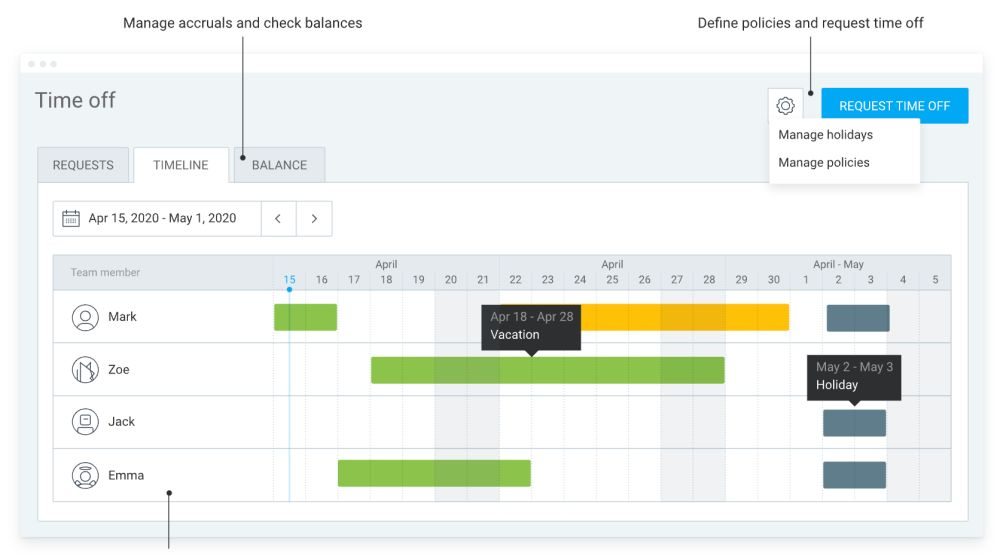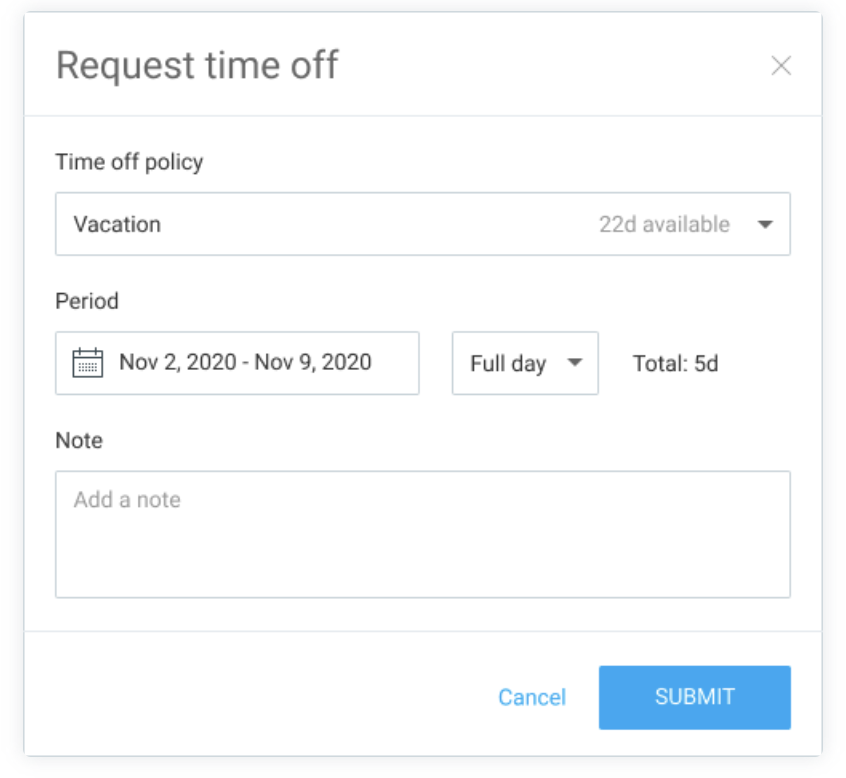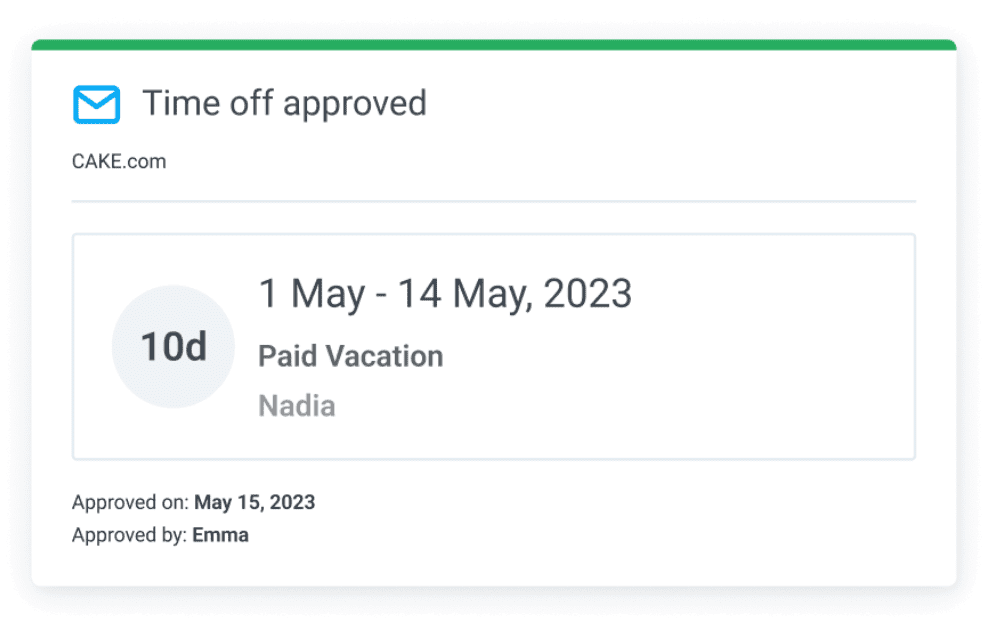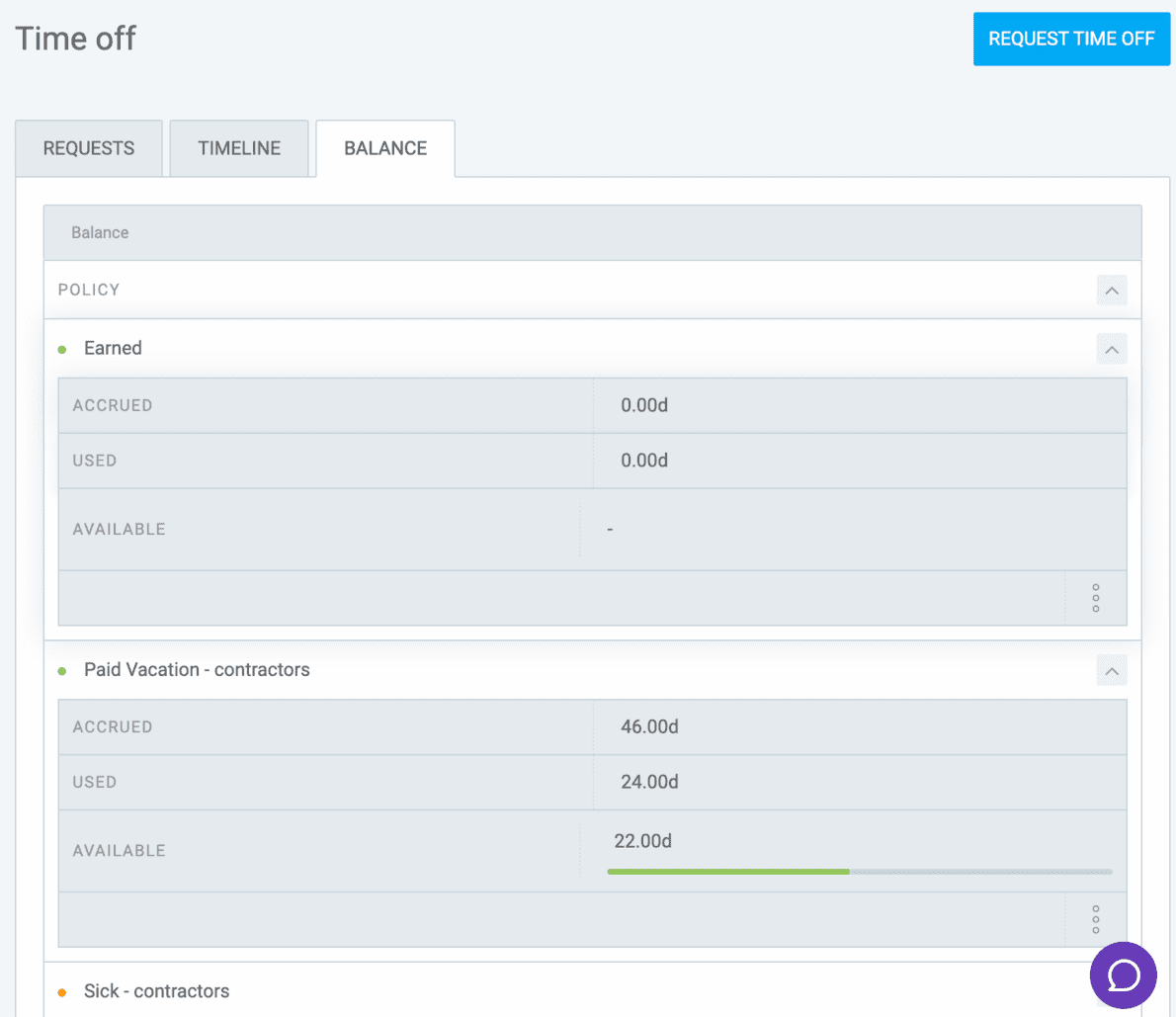Are you ready for a vacation?
Just imagine — a beach, sand, palm trees, your favorite cocktail in one hand and ice cream in the other. The sun is shining, you feel a summer breeze on your face, and you’re perfectly relaxed.
But before you clock off from your job and head to your well-deserved break, you need to submit a vacation request.
Or is that a PTO request?
Is there a difference?
In this blog post, you’ll learn:
- What PTO, vacation, and sick leave are,
- How to choose the best PTO policy, and
- The answers to the most frequently asked questions regarding taking time off.

Table of Contents
What is PTO?
PTO is an abbreviation for paid time off. Paid time off is an employee leave policy that refers to the time you take off from work with no loss of pay. Federal law does not contain any regulations regarding paid time off.
To get an expert definition of essential terms regarding time off, we contacted Armine Alajian, Founder and CPA at The Alajian Group. She differentiated PTO from specific time off policies:

“Essentially, PTO is the policy that houses the other types of time off, like vacation time and sick leave.”
According to the US Department of Labor, reasons for taking PTO can vary and typically include:
- Emergencies,
- Sudden necessities,
- Planned vacations, and
- Illnesses.
In some companies, PTO includes:
- Vacation days,
- Sick days,
- Personal days, and
- Holidays — all in one.
This kind of plan is called a consolidated leave plan. In other companies, these leaves are treated separately.
Is PTO the same as vacation?
Vacation generally refers to scheduling time off from work to rest and recharge.
Alajian highlights the planned aspect of vacation time:

“Vacation time is a specific portion of PTO that employees can use for leisure. It is typically pre-approved and scheduled in advance.”
Vacation time is crucial in helping people achieve work-life balance. It gives employees enough room to spend quality time outside of work.
So, the straightforward answer to the vacation vs. PTO dilemma is that PTO and vacation time aren’t the same. Vacation can be a part of a company’s PTO policy or be treated as a separate time off policy, depending on the structure of their payroll system.
But are vacation time and related services paid?
According to the FLSA, employers in most US states are not required to offer paid vacation to their employees. They have the freedom to offer or deny vacation pay as part of their payroll and benefits package.
💡 Clockify Pro Tip
If you’re getting ready for a vacation, you might find it a bit more difficult to focus on your daily tasks. Luckily, we’ve got you covered:
What is sick leave?
Sick leave presents days off workers take to recover from illnesses or serious medical issues.
Alajian points out that employees usually take sick leave on short notice:

“Sick leave is another type of PTO that allows employees to take time off from work due to illness, injury, or medical appointments. It is intended to provide employees with the necessary time to recover or seek medical care without losing their regular pay. Sick leave is often taken on short notice due to unforeseen circumstances, while vacation time is usually pre-approved in advance.”
So, is sick leave paid or not?
Employees are allowed to take unpaid sick leave for “recovering from one’s own serious illness or caring for a seriously ill loved one,” according to the FMLA. However, the federal law doesn’t specify any requirements for paid sick leave.
Thus, some employers may include sick leaves within their paid time off policies. But this decision is completely up to the employer.
PTO vs. vacation and sick time: Key differences
There are many differences between PTO, sick time, and vacation — from the level of flexibility that comes with these 3 types of leave to the difficulty of keeping track of them.
Let’s take a closer look at what exactly makes them different:
| PTO | Vacation | Sick time |
|---|---|---|
| PTO includes any paid time off. | Vacation is a period specifically designed for leisure. | Sick time presents a leave for recovering from medical problems. |
| PTO offers a high level of flexibility as it’s a broader term. | Vacation time is less flexible — since employees need to use their leave based on the vacation policy. | Sick leave is less flexible as it can only be used for medical purposes. |
| PTO can be planned or unplanned. | Vacation is typically scheduled in advance. | Sick leave is usually taken on short notice. |
| PTO is easier to track as a single policy usually covers several different types of leaves. | Vacation days are usually offered separately from sick days and other types of leave — so they are more complicated to keep track of. | Sick leave is typically unplanned as it usually involves medical emergencies, making it harder to predict and track. |
PTO policies: How to choose the best one
A good PTO policy can be one of the main benefits that attract potential employees. So, it’s something companies need to invest time and effort in.
As an employer, you have the freedom to choose your company’s PTO policy as well as the way your workers earn their time off. The most popular PTO policies include:
- PTO accrual (accrued PTO),
- Bank of PTO, and
- Unlimited PTO.
Accrued PTO means that the number of days off an employee can take is directly proportional to the number of days the employee has worked during the year. However, the number of days workers accumulate each week or month is up to the company.
Bank of PTO includes employers offering workers a fixed number of PTO all at once. The number usually resets on January 1st or, in some instances, on the dates the employees started working. With this policy, there is no separation between categories (vacation, sick leave, personal days off).
Lastly, unlimited PTO is usually a benefit that allows employees to take time off whenever they need it, as long as it doesn’t interfere with their work. There’s no maximum number of days they can take.
Aside from the type of policy, employers also have to choose how the time off is grouped. You can choose between consolidated and separate leave plans, which we’ll further explain in the next section.
💡 Clockify Pro Tip
Creating a good PTO policy helps you attract better employees and ensure your workers rest properly. We have great templates to make the process much easier:
Consolidated vs. separate leave plans — which is better?
If you don’t choose a leave plan that works for your company, you may not be able to reap all of the PTO benefits you normally would. That could happen if you don’t consider some of the pros and cons of separate and consolidated leave plans.
Consolidated leave plans include all types of leave — vacation, sick leave, personal days, etc.
Your workers would have a number of days off they can use for whatever they need. This allows for more flexibility and freedom when taking time off, which can relieve employees of pressure to explain their reasons for using their leave.
Moreover, a consolidated plan is less of an administrative headache since it covers different types of leave. Thus, it’s much easier to keep track of employees’ time off.
In addition, consolidated PTO is better for multicultural environments, as it’s more inclusive. It allows each employee to take time off to celebrate their holidays — even if they’re not widely celebrated in the country or city they live in.
On the other hand, a separate leave plan means creating various PTO policies and assigning each one a specific number of days off. You could allocate days for vacation, personal days, sick leave, parental leave, etc.
When employees want to use their time off, they have to choose the type of leave they wish to take and provide an explanation of their request.
A key benefit to offering different types of leave is that it discourages workers from coming to work sick so they can have more vacation days available, as these policies would then be separate. This is especially important as CivicScience reports that 35% of Americans showed up to their offices while sick in 2021.
11 Most frequently asked questions about PTO and vacation
Do you want to learn more about the benefits of PTO? Still confused about what PTO really means for your business? Let’s clear away any confusion!
1. Is it better to use PTO than vacation?
Is it better to use up your personal PTO days or vacation days when taking a vacation?
Well, that depends on your company’s PTO policy. In the US, your employer doesn’t have to provide you with paid leave. So, you’ll first have to check whether your company even has paid leave available.
If your employer offers paid leave, specifically, separate paid leave policies, the best option is to use the vacation days you have available for vacation. That’s because the main purpose of a separate leave policy is to allow employees to take time off for various purposes so they can properly rest and take care of their affairs.
For consolidated leave plans, you can use your time off for whatever reason as all of the time off policies are unified.
But, what if your company doesn’t offer paid vacation, and you can’t afford to take any unpaid days off? Well, in that case, you could check your options with your employer and see whether you could negotiate additional employee benefits.
2. Does my company have to give me PTO?
In case you live in Europe, you’re entitled to at least 20 days of time off per year.
On the other hand, if you live in the US, it’s pretty much the same as with vacation time — your employer is usually not legally required to give you PTO.
However, an increasing number of US employers are becoming aware of the importance of preventing burnout and taking a break from work.
That’s probably why 79% of civilian workers and 81% of private industry employees had access to paid holidays in 2022. Moreover, 77% of civilian employees and 79% of those working in the private sector had access to paid vacation. Finally, paid sick leave was available for 79% of civilian employees and 77% of private industry workers.
3. How far in advance should I request time off?
The earlier the better.
In general, it’s best to consult your employment contract to see when you can request time off.
Some companies require two weeks’ notice. In others, you need to place your request at least 30 days in advance, or even submit a request 3 or 6 months prior to your time off.
💡 Clockify Pro Tip
Employers with many workers can find it difficult to keep track of their team’s time off. This blog post has great tips on how to easily track time off in your company:
4. What happens if I don’t use my PTO?
First of all — you should definitely use your PTO.
Life is not just about work and taking time off is beneficial to your mental health and overall well-being.
Also, being overworked affects productivity — and not in a positive way.
If you firmly decided you don’t want to use those days off, your company’s policy or the laws in your state dictate what happens to unused PTO. Here are the most common scenarios for unused PTO:
- Days you haven’t used will carry over into the next year,
- You will be able to “cash them out,” or
- You will lose them — that’s the so-called ‘Use-It-Or-Lose-It’ policy.
💡 Clockify Pro Tip
If you haven’t used your PTO and you’re not sure whether your employer is required to offer you compensation, make sure to stay up to date with PTO payout regulations in your state:
5. What happens if I don’t use my vacation days?
In case your employer offered you paid vacation and you decided not to use it, you should check your employment contract to see what happens with your vacation days.
Some companies allow employees to carry over their unused vacation days into the next year. Others expect their employees to use their vacation time by the end of the year.
Keep in mind that in some states — such as California — employers are required to pay you for any unused time off.
So, make sure to check your state labor laws for more information on vacation time.
6. How many days of time off is average?
In the US, the average number of PTO primarily depends on the:
- Industry,
- Years of service, and
- Type of PTO policy.
For instance, private-sector employees with separate leave plans with one year of service had 8 days of paid leave on average. On the other hand, public-sector employees with the same service length had 9 days of paid leave on average.
Both private-sector and civilian US workers with consolidated leave plans had 14 days off on average in 2022.
Many European countries have set the minimum number of paid days off companies can offer. Most countries offer a minimum of 20 paid days off. On the other hand, in the majority of Canadian provinces and in Japan, the minimum number of days off is 10.
7. When should I use PTO?
When and how you use your PTO depends on your company’s policy. That’s because time off rules are not universal. So, always double-check your employment contract.
However, you should generally be able to use PTO whenever you want, given that you got approval from your supervisor. Your days off may not be approved if that period is particularly busy or another coworker is off work at the same time.
If you’re a new hire, you may have to wait a certain amount of time before you can start using your PTO.
💡 Clockify Pro Tip
If you’re having difficulties focusing on simple tasks, perhaps your mental energy is drained and it’s time to take some time off. Here are other things you can do to feel better:
8. Can I be forced to work during PTO or vacation?
In general, you should not be forced to work during your days off.
But, some employers may include this possibility within the fine print of their employment contracts. Thus, you have to check your contract to make sure you can use your days off without having to check in at work.
💡 Clockify Pro Tip
An employer forcing you to work during your days off is one of the signs of a toxic work environment. Read more about this topic here:
9. Can I take time off if I don’t have any PTO or vacation days left?
What happens if you run out of your time off? Can you still take a break from work?
Well, you can take unpaid time off. As the name suggests, it’s the time taken off from work not compensated by an employer.
Leave-without-pay policies, just like PTO policies, differ from company to company. Moreover, some employers may offer it in place of PTO.
10. What does PTO mean for holidays?
Your employer doesn’t have to provide you with paid holidays unless you’re a federal employee (postal worker, office clerk, lawyer, or accountant).
Still, according to research by the US Bureau of Labor Statistics, 81% of private industry workers had access to paid holiday leave in March of 2022.
The same research also shows that the highest-paid workers are more likely to have paid holiday benefits. For instance, 95% of the highest earning private sector employees had paid holiday available in March of 2022.
💡 Clockify Pro Tip
There are 11 federally-recognized holidays. Still, employers are not required to pay workers for any of them. Learn more about paid holidays and how they work in this blog post:
11. Should I track my time off?
Tracking your time off makes it easier for your managers to stay on top of your overall balance and organize work accordingly. This way, they’ll know exactly when each employee will be absent from work.
What’s more, using a PTO tracker can make your workdays a lot easier as well.
Since tracking your time off gives you a visual overview of both accrued and the time off you have available, you’ll always be able to plan your time off in advance and balance your private life and work more efficiently.

Some time off trackers, such as Clockify, give you the option to request time off, which saves everyone a lot of time and trouble.

Use Clockify to get days off requests approved quickly
Remember the jitteriness once you ship out your time off request? That feeling of uncertainty about whether your vacation leave request will be approved or denied?
With a PTO tracker like Clockify, you get an instant notification of whether you’re going on that well-deserved vacation.
With Clockify, you don’t have to wait for your boss to write a lengthy email approving your request. You just request the time off (as we’ve shown above) — and off you go to that beach with palm trees.
Here’s what the first step to that beach looks like:

But sometimes you don’t know how many days off you’ve got left.
In that case, you can check your balance in Clockify.
Simply follow these steps to learn how many used, accrued, or available days off you have left:
- Go to your Time off tab, and
- Click on Balance.

With this information, you can better understand whether you’ve used up your time off sooner than expected.
Sure, you never know whether your supervisor will approve your time off request.
But you can make it easier for them by using a PTO tracker app.
Fingers crossed for that vacation request.


